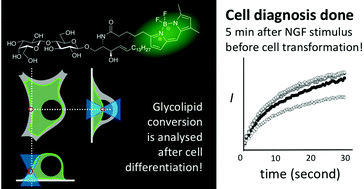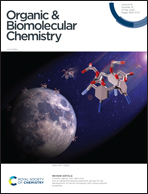Discrimination of cellular developmental states focusing on glycan transformation and membrane dynamics by using BODIPY-tagged lactosyl ceramides†
Abstract
Glycosphingolipids (GSLs) are a group of molecules composed of a hydrophilic glycan part and a hydrophobic ceramide creating a diverse family. GSLs are de novo synthesised from ceramides at the endoplasmic reticulum and Golgi apparatus, and transported to the outer surface of the plasma membrane. It has been known that the glycan structures of GSLs change reflecting disease states. We envisioned that analysing the glycan pattern of GSLs enables distinguishing diseases. For this purpose, we utilised a fluorescently tagged compound, LacCerBODIPY (1). At first, compound 1 was taken up by cultured PC12D cells and transformed into various GSLs. As a result, changes in the GSL patterns of differentiation states of the cells were successfully observed by using an analysis platform, nano-liquid chromatography (LC)-fluorescence detection (FLD)-electrospray ionisation (ESI)-mass spectrometry (MS), which could quantify and provide molecular ions simultaneously. We found that compound 1 remained for about 10 min on the plasma membrane before it was converted into other GSLs. We therefore investigated a more rapid way to discriminate different cellular states by fluorescence recovery after photobleaching, which revealed that it is possible to distinguish the differentiation states as well.

- This article is part of the themed collection: Chemical Biology in OBC


 Please wait while we load your content...
Please wait while we load your content...
